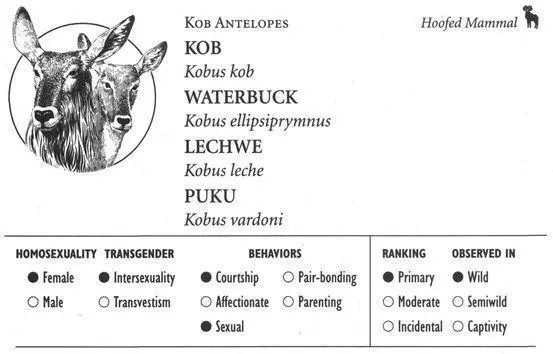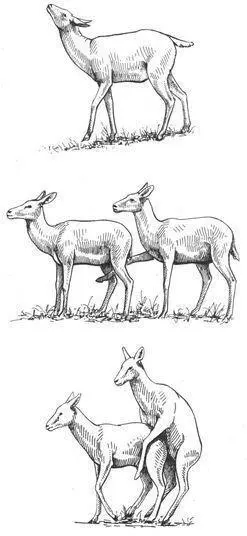Nonreproductive and Alternative Heterosexualities
As described above, the majority of the male population is not involved in procreation, living as they do in bachelor herds or as loners, and Pronghorn social life is characterized by sex segregation for six to seven months of the year. Some bachelors, however, do try to court females; although their advances are consistently rebuffed, the males often persist and may harass the females relentlessly by chasing them, horning and roaring at them, and sometimes even knocking them down during a chase. Reproduction in the Pronghorn is also characterized by aggression within the womb: procreation routinely involves embryos killing each other. As many as seven embryos may initially be present in the female’s uterus, but only two of these will survive. The remainder are killed by the other developing fetuses, which grow long projections out of their fetal membranes that fatally puncture the others and drag them out of the uterus back up into the female’s oviduct. Some embryos also die earlier because they get strangled in the ropelike bodies of the other embryos. The female reabsorbs any embryos that die.
Sources
*asterisked references discuss homosexuality/transgender
Bromley, P. T. (1991) “Manifestations of Social Dominance in Pronghorn Bucks.” Applied Animal Behavior Science 29:147–64.
Bromley, P. T., and D. W. Kitchen (1974) “Courtship in the Pronghorn Antilocapra americana .” In V. Geist and F. Walther, eds., The Behavior of Ungulates and Its Relation to Management, vol. 1, pp. 356–74. IUCN Publication no. 24. Morges, Switzerland: International Union for Conservation of Nature and Natural Resources.
Geist, V. (1990) “Pronghorns.” In Grzimek’s Encyclopedia of Mammals , vol. 5, pp. 282–85. New York: McGraw-Hill.
Geist, V., and P. T. Bromley (1978) “Why Deer Shed Antlers.” Zeitschrift für Säugetierkunde 43:223–31.
*Gilbert, B. K. (1973) “Scent Marking and Territoriality in Pronghorn ( Antilocapra americana ) in Yellowstone National Park.” Mammalia 37:25–33.
*Kitchen, D. W. (1974) “Social Behavior and Ecology of the Pronghorn.” Wildlife Monographs 38:1-96.
O’Gara, B. W. (1978) “ Antilocapra americana.” Mammalian Species 90:1–7.
———(1969) “Unique Aspects of Reproduction in the Female Pronghorn ( Antilocapra americana Ord.)” American Journal of Anatomy 125:217–32.

KOB
IDENTIFICATION: A large grazing antelope with a reddish coat, white underparts, and black markings on the legs; males have lyre-shaped horns, while females are more slender. DISTRIBUTION: Western Kenya to Senegal. HABITAT: Open savanna near water. STUDY AREA: Toro Game Reserve, Uganda; subspecies K.k. thomasi, the Uganda Kob.
WATERBUCK
IDENTIFICATION: A 4-foot-tall (shoulder height) antelope with long, straggly brown or grayish hair and a white rump; males have sickle-shaped, ridged horns. DISTRIBUTION: Sub-Saharan Africa. HABITAT: Grassland, savanna, forest near water. STUDY AREA: Queen Elizabeth Park, Uganda; subspecies K.e. defassa , the Defassa Waterbuck.
LECHWE
IDENTIFICATION: Similar to Kob, but horns longer and thinner, and coat yellowish brown to black. DISTRIBUTION: Southeastern Zaire, Zambia, Botswana. HABITAT: Wetlands. STUDY AREAS: Chobe Game Reserve and Lochinvar National Park, Zambia; subspecies K.l. kafuensis, the Kafue Lechwe.
PUKU
IDENTIFICATION: Similar to Kob but with shorter horns. DISTRIBUTION: Scattered locations throughout south-central Africa. HABITAT: Moist savanna, floodplains, woodland. STUDY AREAS: Kafue National Park and Luangwa Game Reserve, Zambia.
Social Organization
Kob society is complex and is organized around two types of social systems: sex-segregated herds and LEKS. Outside of the breeding grounds, the antelopes congregate in same-sex herds: bachelor herds contain 400–600 males, while female herds usually have 30–50 adults (as well as young of both sexes), though they can contain as many as 1,000 antelopes. On the breeding grounds, the population is structured into a dozen or more small territories known as leks. These are small arenas that the males—and occasionally females—use for performing intricate courtship displays, and which they defend against the intrusion of other males. Females leave their herds to visit these leks, where they choose males to mate with and also interact sexually with other females. The other Kob antelopes also live in sex-segregated female and bachelor herds, although some Lechwe herds are cosexual. In addition, a few males—who do the most mating—are territorial, while some Waterbuck males are SATELLITES, associating with territorial males and occasionally mating with females.
Description
Behavioral Expression: Virtually all Kob females engage in some form of homosexual activity, ranging from simple sexual mounting of other females all the way up to elaborate courtship displays. These interactions usually take place when the females are in heat and may occur either in the female herds or on the leks. Homosexual courtship and sexual interactions consist of a rich array of stylized movements in a fixed sequence, which are all used in heterosexual courtship as well. Individual females vary in how many of these display behaviors they employ when courting another female—some use only one or two, while others employ the full repertoire. A female usually begins her homosexual courtship by PRANCING: she approaches another female with short, stiff-legged steps, her head held high and tail raised. This is followed by an action known as FLEHMEN or LIP-CURLING: she sniffs the vulva of the other female, who crouches and urinates while her partner places her nose in the stream of urine. While doing this, she retracts her upper lip in a curling gesture, exposing a special sexual scenting organ that allows her to sample the odor of the urine. Her courtship dance continues with a stylized gesture known as FORELEG KICKING: she raises her foreleg and gently touches the other female between her legs from behind. The other female responds with ritual MATING-CIRCLING, in which she circles tightly around the courting female, sometimes nipping or butting her hindquarters. This leads to mounting, in which the first female stands on her hind legs and climbs on top of the other from behind, as in heterosexual mating. Sometimes the mounting female gives a single vigorous pelvic thrust, similar to the thrusting that a male makes when he reaches orgasm.
Courtship and sexual activity between female Kob: “prancing” ( above ), “foreleg kicking” ( middle ), and mounting

Following homosexual mounting, female Kob may engage in “inguinal nuzzling” ( left ) and “pincers movement” ( right )

Homosexual copulation may be followed by a further display of stylized behaviors. The courting female, for example, might make a distinctive whistling sound by forcing air loudly through her nostrils with her mouth closed (also made by males in heterosexual courtship). The two females may also engage in what is known as INGUINAL NUZZLING: the female who was mounted adopts a special posture with her hind legs spread wide, tail raised, back arched, and her neck extended in a graceful swanlike position. The other Kob licks her partner’s vulva and udder from behind and then concentrates on nuzzling and licking two special “inguinal glands” located in the same region, which secrete a pungent, waxy substance. Finally, the interaction concludes with what is known as the PINCERS MOVEMENT, in which one female gently holds the other in a “pincers” position with her head on the other Kob’s back and her leg raised underneath her belly. Occasionally, a female Kob will herd other females and even defend her display territory against courting males by attacking the males head-on—no small feat, considering that she does not have the horns that most males use for such purposes. The majority of Kob that participate in homosexual mounting also become pregnant and raise young—and in all cases, this is done in the female-only herds, with little or no participation from males beyond insemination.
Читать дальше















